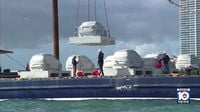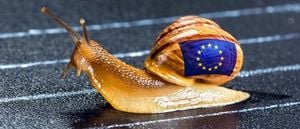South Florida’s coastline is undergoing a transformation that’s as imaginative as it is urgent. The REEFLINE project, a bold fusion of environmental science and contemporary art, officially launched its first phase on October 21, 2025, just off the shores of Miami Beach. Designed to protect and revive the region’s fragile marine ecosystem, REEFLINE is more than just another reef restoration effort—it’s a sprawling underwater gallery, a living experiment, and, for many, a beacon of hope in the face of climate change.
At the heart of this initiative sits an unusual sight: a surreal traffic jam of 22 full-size concrete cars, molded in Homestead and embedded with over 2,000 native corals. This installation, aptly named “Concrete Coral,” is the brainchild of acclaimed Argentine artist Leandro Erlich. “The cars … have the perfect morphology to plant corals,” explained Ximena Caminos, REEFLINE’s founder and artistic director, to NPR. “The cars are kind of like flowerpots for corals. They’re perfect.”
But these aren’t just static sculptures. According to WPLG Local 10, the cars were 3-D printed in marine-grade concrete, allowing divers to attach screw-like bases for coral transplants. The Miami Native Coral Lab, a key partner in the project, has cultivated 2,200 corals specifically for this purpose. Colin Foord, REEFLINE’s Director of Science and co-founder of the Coral Morphologic group, tends to more than 2,000 soft coral specimens in saltwater tanks. “They’re a fundamentally important part of the Caribbean and Floridian coral reef habitat,” Foord told NPR, referencing species like sea fans and sea whips that could eventually reach six feet in height once transplanted onto the sculptures.
The REEFLINE project isn’t just about art or science in isolation; it’s about the synergy between the two. Caminos, who describes herself as a “cultural placemaker,” sees the project as a symbol of what’s possible when creativity and scientific rigor unite. “We can’t stop now,” she told Local 10. “We’re at one of the biggest climate tipping points. If we don’t act, in 100 years the reef will be gone.”
The project is also deeply collaborative, pulling together scientists, artists, local government, and the public. In addition to Erlich’s “Concrete Coral,” the first phase will eventually include three other major installations: “The Miami Reef Star,” a collaboration between Puerto Rican artist Carlos Bentancourt and Miami-based Alberto Latorre; “Heart of Okeanos” by British-Italian artist Petroc Sesti; and a fourth piece to be selected through the Blue Arts Award, whose shortlist will be announced in December 2025, with the winner revealed next summer after an artist residency.
Support for REEFLINE comes from a wide array of sources. The City of Miami Beach has been a driving force, with a $5 million bond approved by voters helping to fund the first phase. Additional backing has flowed in from the Miami-Dade County Risk and Resilience Tech Hub, the Global Fund for Coral Reefs, the Knight Foundation, and the Blavatnik Family Foundation. The long-term vision is ambitious: raise $40 million and create a seven-mile-long reef corridor stretching the length of Miami Beach, a process that could take up to a decade to fully realize.
Community enthusiasm for the project is palpable. “It’s going to transform the environment, the ecology,” local resident Rina Gitlin told Local 10. “It will change the lives of the people here and more importantly, the ocean.” Another supporter, Paula Moreno, added, “This will be an amazing addition for anyone who wants to explore the beach in a new way.”
For Caminos and her team, the project is about more than just ecological restoration. It’s a vision of Miami’s future—one where art and environmental stewardship are intertwined. “I’d love people to see it as a symbol of hope, collaboration, education, science, and tech,” Caminos said. “Ultimately, it’s a symbol of human ingenuity—and how, when we come together, we can tackle anything.”
The REEFLINE project also seeks to restore what was once lost. As NPR reported, Miami Beach had an offshore coral reef until the 1970s, when it was buried under sand brought in for beach replenishment. Foord sees the new artificial reef as a way to “renew and re-create what used to be there,” using resilient local corals that can withstand disease and rising ocean temperatures.
Accessibility is a key component of REEFLINE’s design. The reef will be located in just 15 to 20 feet of water, about 700 feet offshore—close enough for snorkelers to reach without a boat. Caminos envisions the installations, once covered in thriving corals, being visible even from the air as visitors fly into Miami. Future phases include a marine learning center onshore, aimed at educating both locals and tourists about the importance of coral reefs and the threats they face.
The logistical challenges are considerable. Submerging the 22 car-shaped sculptures is a carefully coordinated effort. On October 21, 2025, crews had placed 11 of the cars underwater off South Beach’s South of Fifth neighborhood, with the remaining 11 scheduled for submersion later in the month. Each sculpture is designed not just for visual impact but also for optimal coral growth, with surfaces and shapes that mimic natural reef structures.
The Blue Arts Award adds another layer of excitement and innovation. With nominations closed in June 2025, the shortlist announcement looms in December, followed by a winter residency and a final winner in the summer of 2026. The winning artist will contribute a new installation to the underwater park, ensuring that REEFLINE remains a dynamic, evolving project.
For many involved, the project is a “dream come true.” As Brandi Reddick, REEFLINE’s executive director, put it during a recent beachside event, “The ReefLine would not be possible without our community and the leaders of Miami Beach, so it is so special to be out here with our mayors, our commissioners, and our supporters.”
As the first phase of REEFLINE takes shape beneath the waves, it stands as a testament to Miami’s ability to blend art, science, and civic engagement. With each new coral fragment and sculpted car, the city inches closer to reimagining its relationship with the ocean—one that honors both the beauty and the fragility of the world beneath the surface.




